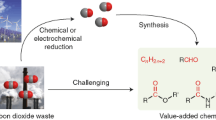Abstract
The reactions of CO2 with oxirane to produce cyclic carbonate, and with aziridine to afford oxazolidine have been of interest as a useful method for its fixation by a chemical process. Highly efficient processes employing recyclable CO2-phlilic homogeneous catalyst were devised for environmentally benign synthesis of cyclic carbonates and oxazolidinones under supercritical CO2 without any organic solvent. These processes represent pathways for greener chemical fixations of CO2 to afford industrial useful materials such as organic carbonates and oxazolidinones with great potential applications.
Similar content being viewed by others
References
Dou X Y, Wang J Q, Du Y, Wang E, He L N. Guanidinium salt functionalized PEG: an effective and recyclable homogeneous catalyst for the synthesis of cyclic carbonates from CO2 and epoxides under solvent-free conditions. Synlett, 2007, 19: 3058–3062
Du Y, Wu Y, Liu A H, He L N. Quaternary ammonium bromide functionalized polyethylene glycol: A highly efficient and recyclable catalyst for selective synthesis of 5-aryl-2-oxazolidinones from carbon dioxide and aziridines under solvent-free conditions. J Org Chem, 2008, 73: 4709–4712
Miao C X, Wang J Q, Wu Y, Du Y, He L N., Bifunctional metalsalen complexes as efficient catalysts for the fixation of CO2 with epoxides under solvent-free conditions. Chem Sus Chem, 2008, 1: 236–241
Du Y, Cai F, Kong D L, He L N. Organic solvent-free process for the synthesis of propylene carbonate from supercritical carbon dioxide and propylene oxide catalyzed by insoluble ion exchange resins. Green Chem, 2005, 7(7): 518–523
Du Y, Wang J Q, Chen J Y, Cai F, Tian J S, Kong D L, He L N. A poly(ethylene glycol)-supported quaternary ammonium salt for highly efficient and environmentally friendly chemical fixation of CO2 with epoxides under supercritical conditions. Tetrahedron Lett, 2006, 47(8): 1271–1275
Miao C X, Wang J Q, He L N. Catalytic processes for chemical conversion of carbon dioxide into cyclic carbonates and polycarbonates. The Open Org Chem J, 2008, 2: 68–82; http://www.bentham.org/open/toocj/openaccess2.htm
Du Y, He L N, Kong D L. Magnesium-catalyzed synthesis of organic carbonate from 1,2-diol/alcohol and carbon dioxide. Catal Commun, 2008, 9: 1754–1758
Darensbourg D J, Holtcamp M W. Catalysts for the reactions of epoxides and carbon dioxide. Coord Chem Rev, 1996, 153: 155–174
Tian J S, Miao C X, Wang J Q, Cai F, Du Y, Zhao Y, and He L N. efficient synthesis of dimethyl carbonate from methanol, propylene oxide and CO2 catalyzed by recyclable inorganic base/phosphonium halide-functionalized polyethylene glycol. Green Chem, 2007, 9: 566–571
Wang J Q, Cai F, Wang E, He L N. Supercritical carbon dioxide and poly(ethylene glycol): an environmentally benign biphasic solvent system for aerobic oxidation of styrene, one-pot synthesis of dimethyl carbonate catalyzed by n-Bu4NBr/n-Bu3N from methanol, epoxides, and supercritical CO2. Green Chem, 2007, 9: 882–887
Tian J S, Wang J Q, Chen J Y, Fan J G, Cai F, He L N. One-pot synthesis of dimethyl carbonate catalyzed by n-Bu4NBr/n-Bu3N from methanol, epoxides, and supercritical CO2. Appl Catal A: Gen, 2006, 301(2): 215–221
Du Y, Kong D L, Wang H Y, Cai F, Tian J S, Wang J Q, He L N. Sncatalyzed synthesis of propylene carbonate from propylene glycol and CO2 under supercritical conditions. J Mol Catal A: Chem, 2005, 241: 233–237
Yasuda H, He L N, Sakakura T. Efficient synthesis of cyclic carbonate from carbon dioxide catalyzed by polyoxometalate: remarkable effects of metal substitution. J Catal, 2005, 233: 119–122
Yasuda H, He L N, Sakakura T. Cyclic carbonate synthesis from supercritical carbon dioxide and epoxide over lanthanide oxychloride. J Catal, 2002, 209: 547–550
Zhao Y, He L N, Zhaung Y Y, Wang J Q. Dimethyl carbonate synthesis via transterification catalyzed by quaternary ammonium salts functionalized chitosan. Chin Chem Lett, 2008, 19: 286–290
Tomishige K, Yasuda H, Yoshida Y, Nurunnabi M, Li B, Kunimori K. Catalytic performance and properties of ceria based catalysts for cyclic carbonate synthesis from glycol and carbon dioxide. Green Chem, 2004, 6: 206–214
Parkin G. Synthetic analogues relevant to the structure and function of Zinc enzymes. Chem Rev, 2004, 104: 699–768
Pacheco M A, Marshall C L. Review of dimethyl carbonate (DMC) manufacture and its characteristics as a fuel additive. Energy Fuels, 1991, 11: 2–29
Aurelio L, Brownlee R T C, Hughus A B. Synthetic preparation of N-methyl-α-amino acids. Chem Rev, 2004, 104: 5823–5846
Author information
Authors and Affiliations
Corresponding author
Rights and permissions
About this article
Cite this article
He, L., Du, Y., Miao, C. et al. Methodologies for chemical utilization of CO2 to valuable compounds through molecular activation by efficient catalysts. Front. Chem. Eng. China 3, 224–228 (2009). https://doi.org/10.1007/s11705-009-0067-y
Received:
Accepted:
Published:
Issue Date:
DOI: https://doi.org/10.1007/s11705-009-0067-y




